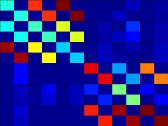| Learning Human Interaction |
|
| Influence Modeling of Multi-agent Interactions |
 |
A stochastic process of human related behaviors normally involves a large and highly structured latent-state (probability) space. The latent structure influence process is a state-space model that effectively compresses the large latent-state space by exploring and exploiting the structure in this space. Compared with other state-space models that do not consider the structure, the latent structure influence process captures more information, is more frugal in its number of parameters, and is less likely to overfit. We have used the latent structure influence process to model the interaction of over one hundred persons and got interesting structural information as well as summaries of individual behaviors that could not be found otherwise. |
| Action-Reaction learning |
 |
Action-Reaction Learning is an approach for
analyzing and synthesizing human behavior. This paradigm uncovers causal
mappings between past and future events or between an action and its
reaction by observing time sequences. We apply this method to analyze
human interaction and to subsequently synthesize human behavior. |
| SCFG-based recognition of interactions in a
parking lot |
 |
The project is a vision-based system that
detects person- person and person-car interactions in a parking lot. The
system detects such events as meeting, walking through, parking the car,
dropping off passengers, picking up passengers and others. The system is
based on a probabilistic Context-Free Grammar parser, where models of
complex interactions can be easily built by specifying an appropriate
grammar. |
| CHMM- based recognition of person
interactions |
 |
The project is a real-time computer vision
and machine learning system for modeling and recognizing human behaviors
in a visual surveillance task. The system is particularly concerned with
detecting when interactions between people occur and classifying the
type of interaction. The interaction is modeled with a novel Coupled
Hidden Markov Model. |
![]()